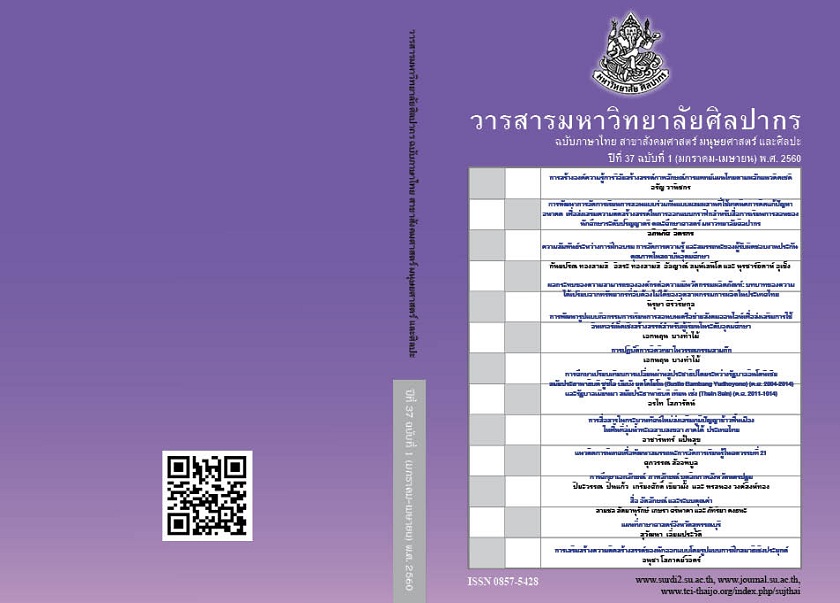การศึกษาเปรียบเทียบการเปลี่ยนผ่านสู่ประชาธิปไตยระหว่างรัฐบาลอินโดนีเซีย สมัยประธานาธิบดี ซูซิโล บัมบัง ยุดโดโยโน (Susilo Bambang Yudhoyono) (ค.ศ. 2004-2014) และรัฐบาลเมียนมา สมัยประธานาธิบดี เทียน เซ่ง (Thein Sein) (ค.ศ. 2011-1014) (A Comparative Study on the Transitional to Democracy between Susilo Bambang Yudhoyono Government and Thein Sein Government)
Main Article Content
Abstract
อินโดนีเซียและเมียนมาเคยเป็นประเทศใต้อาณานิคมและปกครองด้วยระบบทหาร ทั้งสองประเทศ อาจกล่าวได้ว่าเริ่มอยู่ในกระบวนการเปลี่ยนผ่านเข้าสู่ความเป็นประชาธิปไตยในระยะเวลาใกล้เคียงกัน คือหลังสงครามเย็น ประเทศอินโดนีเซียเปลี่ยนผ่านอย่างโดดเด่น ในสมัยประธานาธิบดียุดโดโยโน ส่วนประเทศเมียนมาเปลี่ยนผ่านอย่างเด่นชัดในสมัยประธานาธิบดีเทียน เซ่ง บทความนี้มุ่งศึกษากระบวนการเปลี่ยนผ่านสู่ประชาธิปไตยของทั้งสองรัฐบาลภายใต้กรอบการเปลี่ยนผ่านสู่ประชาธิปไตย(Transitional to Democracy Model) โดยดังค์วาร์ท เอ รัสตาว (Dunkwart A. Rustow) ผลการศึกษาพบว่า อินโดนีเซียมีปัจจัยส่งเสริมการเปลี่ยนผ่านสู่ประชาธิปไตยอย่างมีประสิทธิภาพมากกว่าเมียนมา เมื่อประธานาธิบดี ยุดโดโยโน เน้นในหลักนิติรัฐ ความเสมอภาคระหว่างคนเกาะและไม่ใช่เกาะ เปิดเสรีของสื่อมวลชน และการกระจายอำนาจสู่ท้องถิ่น ในขณะที่เมียนมาเปิดเสรีทางเศรษฐกิจมากขึ้นเพื่อรองรับการลงทุนจากต่างชาติ เปิดเสรีภาพทางด้านสื่อเพิ่มมากขึ้นและปล่อยนักตัวนักโทษทางการเมืองเช่น นางอองซานซูจี รวมถึงยอมให้นางอองซานซูจี ลงสมัครเลือกตั้งในนามตัวแทนพรรคการเมืองเป็นต้น แต่ตราบใดที่ ทั้งสองประเทศยังคงทหารอยู่ในสภาในจำนวนที่แน่นอนตามรัฐธรรมนูญ ความเป็นประชาธิปไตยของทั้งสองประเทศยังคงต้องอาศัยเวลาเปลี่ยนผ่านจนกว่าจะไร้เงาทหารในสภาได้อย่างสมบูรณ์
Downloads
Article Details
References
Bunte, M . (2013). Burma’s Transition to Quasi-Military Rule: From Rulers to Guardians?. Armed Forces and Society, 40(4): 742–64.
Chandiramani ,S. (2008). Burma and Western Precepts of Democracy. Economic and Political Weekly, 43(39): 25-27.
Chamber, P. (2014). Constituti’sonal Change and Security Forces in Southeast Asia: Lessons from Thailand and Myanmar. Contemporary Southeast Asia 36(1):119-120.
Coleman, I. and Lawson-Remer, T. (eds.) (2013). Pathways to Freedom: Political and Economic Lessons from Democratic Transitions. New York: Council on Foreign Relations.
Country Overview, Indonesia. (2014). Worldbank. [Online] Retrieved Novermber, 2014 from http://www.worldbank.org/en/country/Indonesia/overview.
Corruption Perception Index. (2012). Transparency International: The Global Coalition against Corruption. [Online] Retrieved June 10, 2015 from http://www.transparency.org/cpi2012/results.
Diamond, L. (2010). Indonesia's Place in Global Democracy. In Problems of Democratization in Indonesia Elections, edited by Edward Aspinall and Marcus Mietzner. Singapore: Institute of Southeast Asia Studies.
Economist, The. (1999). Habibiie’s Task. [Online] Retrieved November, 2014 from http://www.economist.com/node/183818.
Economist, The. (2010). Gus Dur. [Online] Retrieved June 10, 2015 from http://www.economist.com/node/15211074.
Fukuyama, F. (2013). Democracy and the Quality of the State. Journal of Democracy, 24(4): 5-16.
Fasman, J. (2014). Indonesia’s Fresh Start. The Economist. Retrieved November 20,2014 from http://www.economist.com/news/21631850-pragmatic-president-will-find-it-harder-get-things-done-nationally-he-did-locally-indonesias.
Freedom in the World Indonesia. (2012). Freedom House. [Online] Retrieved June 11, 2015 from https://freedomhouse.org/report/freedom-world/2012/indonesia#.VXpnHsIVjjE.
Gred Fealy, Gus Dur’s 100 days. (2010). Inside Indonesia. [Online] Retrieved June 10, 2015 from http://www.insideindonesia.org/gus-dur-s-100-days.
Mcdermott, D. and Borsuk, R. (1997) Suharto Speculation Sends Rupiah Plungging 10%,Despite IMF Plan. Wall Street Journal. [Online] Retrieved June 2015 from http://www.wsj.com/articles/SB88167699136201500.
Myanmar Economic Monitor. (2013). World Bank Group. [Online] Retrieved November, 2015 from https://www.worldbank.org/content/dam/Worldbank/document/EAP/Myanmar/Myanmar_Economic_Monitor_October_2013.pdf
Platter, M. F. (2014). The End of the Transitions Era?. Journal of Democracy, 25(3): 5-16.
Purdey, J. (2006) Anti-Chinese Violence in Indonesia, 1996–1999. Singapore: Singapore University Press.
Rieffel, L. (2010). The Economy of Burma/ Myanmar on the Eve of the 2010. Elections: Special Report. Washington, D.C.: United States Institute of Peace.
Rustow, D. A. (1970). Transition to Democracy: Toward a Dynamic Model. Comparative Politics, 2(3): 337-363.
Schreiner, K. H. (2005). Histories of Trauma and Sites of Memory. In Beginning to Remember: The Past in the Indonesian Present, edited by Mary S. Zurbuchen. Singapore: Singapore University Press.
Tangtrongphairoj, S. (2008) New Order: A Support Instrument of Suharto’s Power (ระเบียบใหม่ (OrdeBaru):เครื่องมือค้ำจุนอำานาจของประธานาธิบดีซูฮาร์โต). Institute of Asian Studies Chulalongkorn University [Online] Retrieved November ,2015 from http://www.thaiworld.org/thn/include/print. php?text=737&category_id=3&print=true.
Taylor, R. H. (2013). Myanmar in 2012: Mhyaw Ta Lin Lin or Great Expectation. Southeast Asian Affairs, 2013: 189-203.
Vogt, B. (2014) The Path To Civilian Rule in Burma Goes through Indonesia. Center for National Policy. [Online] Retrieved on June 11, 2015 from http://cnponline.org/wp-content/uploads/2014/04/The-Path-to-Civilian-Rule-in-Burma-Goes-through-Indonesia.pdf.


